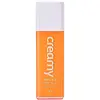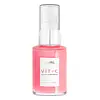What's inside
What's inside
 Key Ingredients
Key Ingredients

 Benefits
Benefits

 Concerns
Concerns

 Ingredients Side-by-side
Ingredients Side-by-side

Water
Skin ConditioningAscorbyl Glucoside
AntioxidantDipropylene Glycol
HumectantGlycerin
HumectantEthoxydiglycol
Humectant3-O-Ethyl Ascorbic Acid
Skin ConditioningTocopheryl Acetate
AntioxidantXanthan Gum
EmulsifyingFerulic Acid
AntimicrobialSclerotium Gum
Emulsion StabilisingLecithin
EmollientPhenoxyethanol
PreservativePullulan
Silica
AbrasiveEthylhexylglycerin
Skin ConditioningSodium Hyaluronate
HumectantWater
Skin ConditioningAscorbic Acid
AntioxidantCassia Angustifolia Seed Polysaccharide
Skin ConditioningGlycerin
HumectantAloe Barbadensis Leaf Extract
EmollientCollagen
MoisturisingHibiscus Sabdariffa Flower Powder
AbrasiveDimethyl Sulfone
SolventCamellia Sinensis Extract
AntioxidantSimmondsia Chinensis Seed Oil
EmollientHamamelis Virginiana Water
AstringentCentella Asiatica Extract
CleansingEquisetum Arvense Extract
AstringentTaraxacum Officinale Extract
Skin ConditioningFucus Vesiculosus
Skin ConditioningXanthan Gum
EmulsifyingTocopheryl Acetate
AntioxidantJasminum Grandiflorum Flower Extract
MaskingCistus Ladaniferus Oil
EmollientCI 77492
Cosmetic ColorantEthylhexylglycerin
Skin ConditioningWater, Ascorbic Acid, Cassia Angustifolia Seed Polysaccharide, Glycerin, Aloe Barbadensis Leaf Extract, Collagen, Hibiscus Sabdariffa Flower Powder, Dimethyl Sulfone, Camellia Sinensis Extract, Simmondsia Chinensis Seed Oil, Hamamelis Virginiana Water, Centella Asiatica Extract, Equisetum Arvense Extract, Taraxacum Officinale Extract, Fucus Vesiculosus, Xanthan Gum, Tocopheryl Acetate, Jasminum Grandiflorum Flower Extract, Cistus Ladaniferus Oil, CI 77492, Ethylhexylglycerin
Ingredients Explained
These ingredients are found in both products.
Ingredients higher up in an ingredient list are typically present in a larger amount.
Ethylhexylglycerin (we can't pronounce this either) is commonly used as a preservative and skin softener. It is derived from glyceryl.
You might see Ethylhexylglycerin often paired with other preservatives such as phenoxyethanol. Ethylhexylglycerin has been found to increase the effectiveness of these other preservatives.
Glycerin is already naturally found in your skin. It helps moisturize and protect your skin.
A study from 2016 found glycerin to be more effective as a humectant than AHAs and hyaluronic acid.
As a humectant, it helps the skin stay hydrated by pulling moisture to your skin. The low molecular weight of glycerin allows it to pull moisture into the deeper layers of your skin.
Hydrated skin improves your skin barrier; Your skin barrier helps protect against irritants and bacteria.
Glycerin has also been found to have antimicrobial and antiviral properties. Due to these properties, glycerin is often used in wound and burn treatments.
In cosmetics, glycerin is usually derived from plants such as soybean or palm. However, it can also be sourced from animals, such as tallow or animal fat.
This ingredient is organic, colorless, odorless, and non-toxic.
Glycerin is the name for this ingredient in American English. British English uses Glycerol/Glycerine.
Learn more about GlycerinTocopheryl Acetate is AKA Vitamin E. It is an antioxidant and protects your skin from free radicals. Free radicals damage the skin by breaking down collagen.
One study found using Tocopheryl Acetate with Vitamin C decreased the number of sunburned cells.
Tocopheryl Acetate is commonly found in both skincare and dietary supplements.
Learn more about Tocopheryl AcetateWater. It's the most common cosmetic ingredient of all. You'll usually see it at the top of ingredient lists, meaning that it makes up the largest part of the product.
So why is it so popular? Water most often acts as a solvent - this means that it helps dissolve other ingredients into the formulation.
You'll also recognize water as that liquid we all need to stay alive. If you see this, drink a glass of water. Stay hydrated!
Learn more about WaterXanthan gum is used as a stabilizer and thickener within cosmetic products. It helps give products a sticky, thick feeling - preventing them from being too runny.
On the technical side of things, xanthan gum is a polysaccharide - a combination consisting of multiple sugar molecules bonded together.
Xanthan gum is a pretty common and great ingredient. It is a natural, non-toxic, non-irritating ingredient that is also commonly used in food products.
Learn more about Xanthan Gum